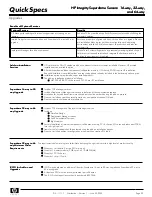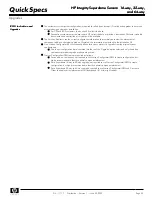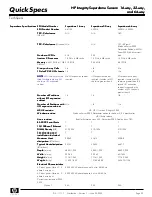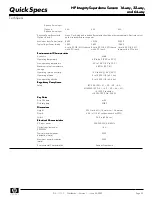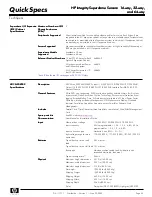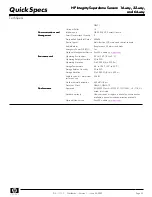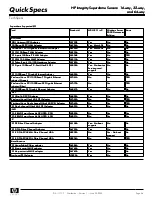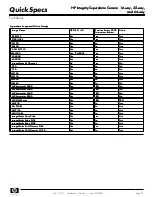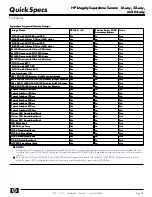
33
33
33
33
Same amount of memory in each cell, but non optimal and/or mixed loading within a cell
Same amount of memory in each cell, but non optimal and/or mixed loading within a cell
Same amount of memory in each cell, but non optimal and/or mixed loading within a cell
Same amount of memory in each cell, but non optimal and/or mixed loading within a cell
(for instance, a two cell configuration with 16 512MB DIMMs and 8 1GB DIMMs in each
(for instance, a two cell configuration with 16 512MB DIMMs and 8 1GB DIMMs in each
(for instance, a two cell configuration with 16 512MB DIMMs and 8 1GB DIMMs in each
(for instance, a two cell configuration with 16 512MB DIMMs and 8 1GB DIMMs in each
cell).
cell).
cell).
cell).
34
34
34
34
Non-uniform amount of memory across cells (this needs to boot and run, but performance is
Non-uniform amount of memory across cells (this needs to boot and run, but performance is
Non-uniform amount of memory across cells (this needs to boot and run, but performance is
Non-uniform amount of memory across cells (this needs to boot and run, but performance is
whatever you get).
whatever you get).
whatever you get).
whatever you get).
35
35
35
35
For the same amount of total memory, best performance is with a larger number of smaller
For the same amount of total memory, best performance is with a larger number of smaller
For the same amount of total memory, best performance is with a larger number of smaller
For the same amount of total memory, best performance is with a larger number of smaller
size DIMMs.
size DIMMs.
size DIMMs.
size DIMMs.
Single System
Single System
Single System
Single System
High Availability
High Availability
High Availability
High Availability
36
36
36
36
Each cell should have at least two active CPUs.
Each cell should have at least two active CPUs.
Each cell should have at least two active CPUs.
Each cell should have at least two active CPUs.
37
37
37
37
Each cell should have at least 4 GB (8 DIMMs) of memory using 512-MB DIMMs and at least
Each cell should have at least 4 GB (8 DIMMs) of memory using 512-MB DIMMs and at least
Each cell should have at least 4 GB (8 DIMMs) of memory using 512-MB DIMMs and at least
Each cell should have at least 4 GB (8 DIMMs) of memory using 512-MB DIMMs and at least
8 GB of memory using 1-GB DIMMs.
8 GB of memory using 1-GB DIMMs.
8 GB of memory using 1-GB DIMMs.
8 GB of memory using 1-GB DIMMs.
38
38
38
38
I/O chassis ownership must be localized as much as possible. One way is to assign I/O
I/O chassis ownership must be localized as much as possible. One way is to assign I/O
I/O chassis ownership must be localized as much as possible. One way is to assign I/O
I/O chassis ownership must be localized as much as possible. One way is to assign I/O
chassis to partitions in sequential order starting from INSIDE the single cabinet, then out to
chassis to partitions in sequential order starting from INSIDE the single cabinet, then out to
chassis to partitions in sequential order starting from INSIDE the single cabinet, then out to
chassis to partitions in sequential order starting from INSIDE the single cabinet, then out to
the I/O expansion cabinet 'owned' by the single cabinet.
the I/O expansion cabinet 'owned' by the single cabinet.
the I/O expansion cabinet 'owned' by the single cabinet.
the I/O expansion cabinet 'owned' by the single cabinet.
39
39
39
39
I/O expansion cabinets can be used only when the main system cabinet holds maximum
I/O expansion cabinets can be used only when the main system cabinet holds maximum
I/O expansion cabinets can be used only when the main system cabinet holds maximum
I/O expansion cabinets can be used only when the main system cabinet holds maximum
number of I/O card cages. Thus, the cabinet must first be filled with I/O card cages before
number of I/O card cages. Thus, the cabinet must first be filled with I/O card cages before
number of I/O card cages. Thus, the cabinet must first be filled with I/O card cages before
number of I/O card cages. Thus, the cabinet must first be filled with I/O card cages before
using an I/O expansion cabinet.
using an I/O expansion cabinet.
using an I/O expansion cabinet.
using an I/O expansion cabinet.
40
40
40
40
Single cabinets connected to form a dual cabinet (using flex cables) should use a single I/O
Single cabinets connected to form a dual cabinet (using flex cables) should use a single I/O
Single cabinets connected to form a dual cabinet (using flex cables) should use a single I/O
Single cabinets connected to form a dual cabinet (using flex cables) should use a single I/O
expansion cabinet if possible.
expansion cabinet if possible.
expansion cabinet if possible.
expansion cabinet if possible.
41
41
41
41
Spread enough connections across as many I/O chassis as it takes to become 'redundant' in
Spread enough connections across as many I/O chassis as it takes to become 'redundant' in
Spread enough connections across as many I/O chassis as it takes to become 'redundant' in
Spread enough connections across as many I/O chassis as it takes to become 'redundant' in
I/O chassis'. In other words, if an I/O chassis fails, the remaining chassis have enough
I/O chassis'. In other words, if an I/O chassis fails, the remaining chassis have enough
I/O chassis'. In other words, if an I/O chassis fails, the remaining chassis have enough
I/O chassis'. In other words, if an I/O chassis fails, the remaining chassis have enough
connections to keep the system up and running, or in the worst case, have the ability to
connections to keep the system up and running, or in the worst case, have the ability to
connections to keep the system up and running, or in the worst case, have the ability to
connections to keep the system up and running, or in the worst case, have the ability to
reboot with the connections to peripherals and networking intact.
reboot with the connections to peripherals and networking intact.
reboot with the connections to peripherals and networking intact.
reboot with the connections to peripherals and networking intact.
42
42
42
42
All SCSI cards are configured in the factory as unterminated. Any auto termination is
All SCSI cards are configured in the factory as unterminated. Any auto termination is
All SCSI cards are configured in the factory as unterminated. Any auto termination is
All SCSI cards are configured in the factory as unterminated. Any auto termination is
defeated. If auto termination is not defeatable by hardware, the card is not used at first
defeated. If auto termination is not defeatable by hardware, the card is not used at first
defeated. If auto termination is not defeatable by hardware, the card is not used at first
defeated. If auto termination is not defeatable by hardware, the card is not used at first
release. Terminated cable would be used for connection to the first external device. In the
release. Terminated cable would be used for connection to the first external device. In the
release. Terminated cable would be used for connection to the first external device. In the
release. Terminated cable would be used for connection to the first external device. In the
factory and for shipment, no cables are connected to the SCSI cards. In place of the
factory and for shipment, no cables are connected to the SCSI cards. In place of the
factory and for shipment, no cables are connected to the SCSI cards. In place of the
factory and for shipment, no cables are connected to the SCSI cards. In place of the
terminated cable, a terminator is placed on the cable port to provide termination until the
terminated cable, a terminator is placed on the cable port to provide termination until the
terminated cable, a terminator is placed on the cable port to provide termination until the
terminated cable, a terminator is placed on the cable port to provide termination until the
cable is attached. This is needed to allow HP-UX to boot. The customer does not need to
cable is attached. This is needed to allow HP-UX to boot. The customer does not need to
cable is attached. This is needed to allow HP-UX to boot. The customer does not need to
cable is attached. This is needed to allow HP-UX to boot. The customer does not need to
order the terminators for these factory integrated SCSI cards, since the customer will probably
order the terminators for these factory integrated SCSI cards, since the customer will probably
order the terminators for these factory integrated SCSI cards, since the customer will probably
order the terminators for these factory integrated SCSI cards, since the customer will probably
discard them. The terminators are provided in the factory by use of constraint net logic.
discard them. The terminators are provided in the factory by use of constraint net logic.
discard them. The terminators are provided in the factory by use of constraint net logic.
discard them. The terminators are provided in the factory by use of constraint net logic.
43
43
43
43
Partitions whose I/O chassis are contained within a single cabinet have higher availability
Partitions whose I/O chassis are contained within a single cabinet have higher availability
Partitions whose I/O chassis are contained within a single cabinet have higher availability
Partitions whose I/O chassis are contained within a single cabinet have higher availability
than those partitions that have their I/O chassis spread across cabinets.
than those partitions that have their I/O chassis spread across cabinets.
than those partitions that have their I/O chassis spread across cabinets.
than those partitions that have their I/O chassis spread across cabinets.
44
44
44
44
A partition's core I/O chassis should go in a system cabinet, not an I/O expansion cabinet
A partition's core I/O chassis should go in a system cabinet, not an I/O expansion cabinet
A partition's core I/O chassis should go in a system cabinet, not an I/O expansion cabinet
A partition's core I/O chassis should go in a system cabinet, not an I/O expansion cabinet
45
45
45
45
A partition should be connected to at least two I/O chassis containing Core I/O cards. This
A partition should be connected to at least two I/O chassis containing Core I/O cards. This
A partition should be connected to at least two I/O chassis containing Core I/O cards. This
A partition should be connected to at least two I/O chassis containing Core I/O cards. This
implies that all partitions should be at least 2 cells in size. The lowest number cell or I/O
implies that all partitions should be at least 2 cells in size. The lowest number cell or I/O
implies that all partitions should be at least 2 cells in size. The lowest number cell or I/O
implies that all partitions should be at least 2 cells in size. The lowest number cell or I/O
chassis is the 'root' cell; the second lowest number cell or I/O chassis combo in the partition
chassis is the 'root' cell; the second lowest number cell or I/O chassis combo in the partition
chassis is the 'root' cell; the second lowest number cell or I/O chassis combo in the partition
chassis is the 'root' cell; the second lowest number cell or I/O chassis combo in the partition
is the 'backup root' cell.
is the 'backup root' cell.
is the 'backup root' cell.
is the 'backup root' cell.
46
46
46
46
A partition should consist of at least two cells.
A partition should consist of at least two cells.
A partition should consist of at least two cells.
A partition should consist of at least two cells.
47
47
47
47
Not more than one partition should span a cabinet or a crossbar link. When crossbar links
Not more than one partition should span a cabinet or a crossbar link. When crossbar links
Not more than one partition should span a cabinet or a crossbar link. When crossbar links
Not more than one partition should span a cabinet or a crossbar link. When crossbar links
are shared, the partition is more at risk relative to a crossbar failure that may bring down all
are shared, the partition is more at risk relative to a crossbar failure that may bring down all
are shared, the partition is more at risk relative to a crossbar failure that may bring down all
are shared, the partition is more at risk relative to a crossbar failure that may bring down all
the cells connected to it.
the cells connected to it.
the cells connected to it.
the cells connected to it.
Multi System
Multi System
Multi System
Multi System
High Availability
High Availability
High Availability
High Availability
(Please also refer
(Please also refer
(Please also refer
(Please also refer
to Multi System
to Multi System
to Multi System
to Multi System
High Availability
High Availability
High Availability
High Availability
section following
section following
section following
section following
this table)
this table)
this table)
this table)
48
48
48
48
Multi initiator support is required for Serviceguard. The A5149A adapter will be required
Multi initiator support is required for Serviceguard. The A5149A adapter will be required
Multi initiator support is required for Serviceguard. The A5149A adapter will be required
Multi initiator support is required for Serviceguard. The A5149A adapter will be required
prior to Ultra160 SCSI adapters (A6828A and A6829A) support of multi initiator
prior to Ultra160 SCSI adapters (A6828A and A6829A) support of multi initiator
prior to Ultra160 SCSI adapters (A6828A and A6829A) support of multi initiator
prior to Ultra160 SCSI adapters (A6828A and A6829A) support of multi initiator
environments (available February 2003).
environments (available February 2003).
environments (available February 2003).
environments (available February 2003).
Traditional Multi
Traditional Multi
Traditional Multi
Traditional Multi
System High
System High
System High
System High
Availability
Availability
Availability
Availability
49
49
49
49
To configure a cluster with no SPOF, the membership must extend beyond a single cabinet.
To configure a cluster with no SPOF, the membership must extend beyond a single cabinet.
To configure a cluster with no SPOF, the membership must extend beyond a single cabinet.
To configure a cluster with no SPOF, the membership must extend beyond a single cabinet.
The cluster must be configured such that the failure of a single cabinet does not result in the
The cluster must be configured such that the failure of a single cabinet does not result in the
The cluster must be configured such that the failure of a single cabinet does not result in the
The cluster must be configured such that the failure of a single cabinet does not result in the
failure of a majority of the nodes in the cluster. The cluster lock device must be powered
failure of a majority of the nodes in the cluster. The cluster lock device must be powered
failure of a majority of the nodes in the cluster. The cluster lock device must be powered
failure of a majority of the nodes in the cluster. The cluster lock device must be powered
independently of the cabinets containing the cluster nodes. Alternative cluster lock solution
independently of the cabinets containing the cluster nodes. Alternative cluster lock solution
independently of the cabinets containing the cluster nodes. Alternative cluster lock solution
independently of the cabinets containing the cluster nodes. Alternative cluster lock solution
is the Quorum Service, which resides outside the Serviceguard cluster providing arbitration
is the Quorum Service, which resides outside the Serviceguard cluster providing arbitration
is the Quorum Service, which resides outside the Serviceguard cluster providing arbitration
is the Quorum Service, which resides outside the Serviceguard cluster providing arbitration
services.
services.
services.
services.
50
50
50
50
A cluster lock is required if the cluster is wholly contained within two single cabinets (i.e.,
A cluster lock is required if the cluster is wholly contained within two single cabinets (i.e.,
A cluster lock is required if the cluster is wholly contained within two single cabinets (i.e.,
A cluster lock is required if the cluster is wholly contained within two single cabinets (i.e.,
two Superdome/ 16-way or 32-way systems or two Superdome/PA 8800 32-way or 64-way
two Superdome/ 16-way or 32-way systems or two Superdome/PA 8800 32-way or 64-way
two Superdome/ 16-way or 32-way systems or two Superdome/PA 8800 32-way or 64-way
two Superdome/ 16-way or 32-way systems or two Superdome/PA 8800 32-way or 64-way
systems) or two dual cabinets (i.e. two Superdome/ 64-way systems or two Superdome/PA
systems) or two dual cabinets (i.e. two Superdome/ 64-way systems or two Superdome/PA
systems) or two dual cabinets (i.e. two Superdome/ 64-way systems or two Superdome/PA
systems) or two dual cabinets (i.e. two Superdome/ 64-way systems or two Superdome/PA
QuickSpecs
HP Integrity Superdome Servers: 16-way, 32-way,
HP Integrity Superdome Servers: 16-way, 32-way,
HP Integrity Superdome Servers: 16-way, 32-way,
HP Integrity Superdome Servers: 16-way, 32-way,
and 64-way
and 64-way
and 64-way
and 64-way
Configuration
DA - 11717 Worldwide — Version 1 — June 30, 2003
Page 23





















